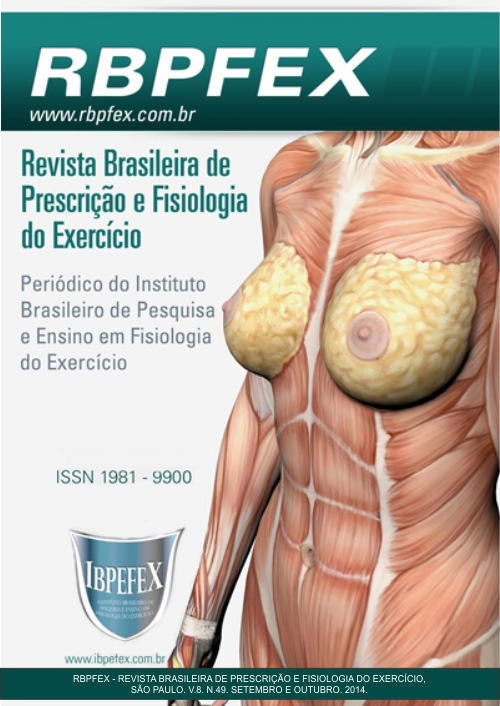Difference in maximum number of repetitions performed by practitioners of Jiu-Jitsu in bench press horizontal using intervals between series
Abstract
The interval is relevant variable resistance training, being quite important adequately implemented during the training period in which the goal is maximum strength gains. The aim of the study is to evaluate the use of 90% of 1-RM as the training zone for increased maximum force to investigate the effects of two intervals (2:5 minutes) the maximum number of repetitions performed over three series in supine horizontal. As you examine the study, the maximum number of repetitions performed under each series, regardless of the time interval: 1st series (2 min.: 5.9 ± 1.0 repetitions; 5 min.: 6.3 ± 1, 2 repetitions), grade 2 (2 min.: 3.9 ± 1.1 repetitions; 5 min.: 4.8 ± 1.4 reps) and grade 3 (2 min.: 2.8 ± 0.9 repetitions; 5 min.: 3.5 ± 1.4 repetitions). The total volume of repetitions achievedshown lower with 2 min. interval (12.6 ± 2.6 repetitions) compared to 5 min. (14.6 ± 3.6 repetitions). It was found that the 5-minute interval provided better recovery between sets of horizontal supine than an interval of 2 minutes.
References
-Barros, C.L.M.; e Colaboradores. Efeitos de Diferentes Intervalos de Recuperação no Número de Repetições Máximas. Rev Min Cie Saúde. Vol. 1. Núm. 1. p. 32-41. 2009.
-Chagas, M.; Barbosa, J.; Lima, F. Comparação do número máximo de repetições realizadas a 40 e 80% de uma repetição máxima em dois diferentes exercícios na musculação entre os gêneros masculino e feminino. Rev. bras. Educ. Fís. Esp. Vol. 19. p. 5-12. 2005.
-Costa, S.; Matos, D.; Silva, A.; Aidar, F.; Rodrigues, B.; Klain, I.; Mazini Filho, M. Influência da privação visual no teste de uma repetição máxima e predição de carga. Revista Brasileira de Ciências da Saúde. Núm. 36. 2013.
-Dias, R.; Cyrino, E.S.; Salvador, E.P.; Caldeira, L.F.S.; Nakamura, F.Y.; Papst, R.R.; Bruna, M.; Gurjão, A.L.D. Influência do processo de familiarização para avaliação da força muscular em testes de 1-RM. Revista Brasileira de Medicina do Esporte. Vol. 11. Núm. 1. p. 34-38. 2005.
-Fleck, S.; Simão, R. Força: Princípios Metodológicos para o Treinamento. Phorte. 2008.
-Hoeger, W.; Barette, S.; Hale, D.; Hopkins, D. The relationship between repetitions and selected percentages of one repetition maximum. Journal of Applied Sport Science Research. Vol. 1. Núm. 1. p. 11-13. 1987.
-Hultman, E.; Sjoholm, H. Biomechanical causes of fatigue. Champaign. Human Kinetics.1986.
-Jones, N.L. (H+) Control in exercise: Concepts and controversies. Champaign. Human Kinetics. 1990.
-Kraemer, W.J.; Noble, B.J.; Clark, M.J.; Culver, B.W. Physiologic responses to heavy-resistance exercise with very short rest periods. International Journal Sports Medicine. Vol. 8. p. 247-252. 1987.
-Matuszak, M.; Fry, A.; Weiss, L.; Ireland, T.; Mcknight, M. Effect of rest interval length on repeated 1 repetition maximum back squats. Journal of strength and conditioning research. Lincoln. Vol. 17. Núm. 4. p. 634-637. 2003.
-Mazini Filho, M.; Rodrigues, B.; Reis, A.; Zanela, A.; Junior, R.; Matos, D. Análise do teste de uma repetição máxima no exercício supino para predição de carga. Brazilian Journal of Biomotricity. Vol. 4. 2010.
-Mcardle, W. D.; Kacth, F. I.; Kacth, V. L. Fisiologia do exercício energia, nutrição e desempenho humano. 5ªedição. Guanabara Koogan. 2003.
-Mccurdy, K.; Langford, G.A.; Cline, A.L.; Dosher, M.; Hoff, R. The reliability of 1 and 3 RM test of unilateral strength in trained and untrained men and women. Journal Sport Science Medicine. Vol. 3. p. 190-196. 2004.
-Rarmalho, G.; Mazini Filho, M.; Rodrigues, B.; Venturini, G; Salgueiro, R.; Junio, R.; Matos, D. O teste de 1-RM para a predição de carga no treino de hipertrofia e sua relação com o número de repetições executadas. Brazilian Journal of Biomotricity. Vol. 5. Núm. 3. 2011.
-Rhea, M.; Alvar, B.; Burkett, L.; Ball, S. A meta-analysis to determine the dose response for strength development. Med. Science Sport Medicine. 2003.
-Rodrigues, B.; Rodrigues, A.; Sandy, D.; Mazini Filho, M.; Dantas, E. The effect of two different rest intervals on the number of repetitions in a training session. Serb J Sports Sci. Vol. 6. Núm. 1. p. 37-41. 2012.
-Sakamoto, A.; Sinclair, P. Effect of movement velocity on the relationship between training loadand the number of repletion of bench press. Journal Strength Cond Res. Vol. 3. p. 523-527. 2006.
-Simão, R.; Aguiar, R.; Miranda, H.; Souto Maior, A. A influência de distintos intervalos de recuperação entre séries nos exercícios resistidos. Fitness & performance journal. Núm. 3. p. 134-138. 2006.
-Simão, R.; Polito, M.; Monteiro, W. Efeitos de diferentes intervalos de recuperação em um programa de treinamento de força para indivíduos treinados. Rev. Bras Med Esporte. Vol. 14. Núm. 4. 2008.
-Weis, J.P.; Wagner, L.L.; Housh, T.J. The effect of rest interval length on repeated maximal bench presses. Journal Strength Conditioning Research. Vol. 8. p. 58-60. 1994.
-World Health Organization. Obesity: preventing and managing the global epidemic. Report of the WHO Consultation on Obesity. Geneva: World Health Organization.1998.
-Willardson, J.M.; Burkett, L.N. Comparison of 3 different rest intervals on the exercise.Volume completed during a workout. Journal of strengthand conditioning research. 2005.
Authors who publish in this journal agree to the following terms:
- Authors retain the copyright and grant the journal the right of first publication, with work simultaneously licensed under the Creative Commons Attribution License BY-NC which allows the sharing of the work with acknowledgment of the authorship of the work and initial publication in this journal.
- Authors are authorized to enter into additional contracts separately for non-exclusive distribution of the version of the work published in this journal (eg, publishing in institutional repository or book chapter), with acknowledgment of authorship and initial publication in this journal.
- Authors are allowed and encouraged to post and distribute their work online (eg, in institutional repositories or on their personal page) at any point before or during the editorial process, as this can bring about productive change as well as increase impact and impact. citation of published work (See The Effect of Free Access).






